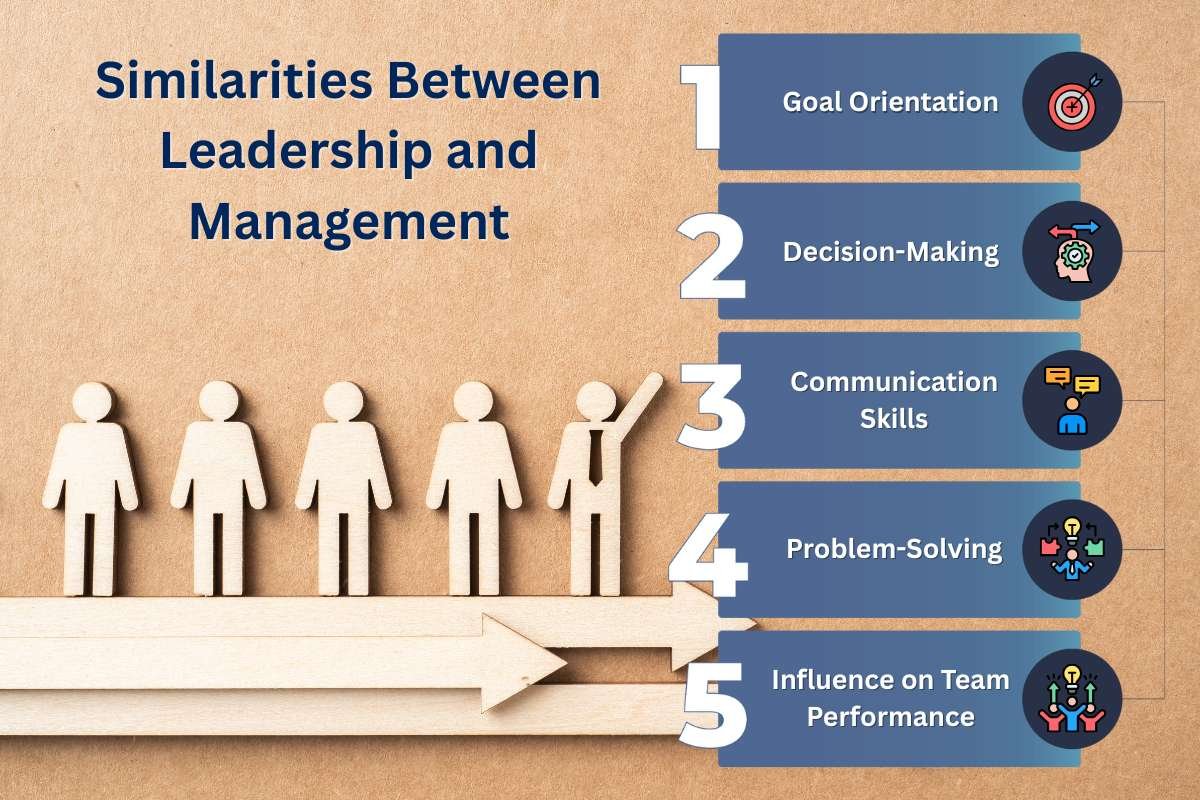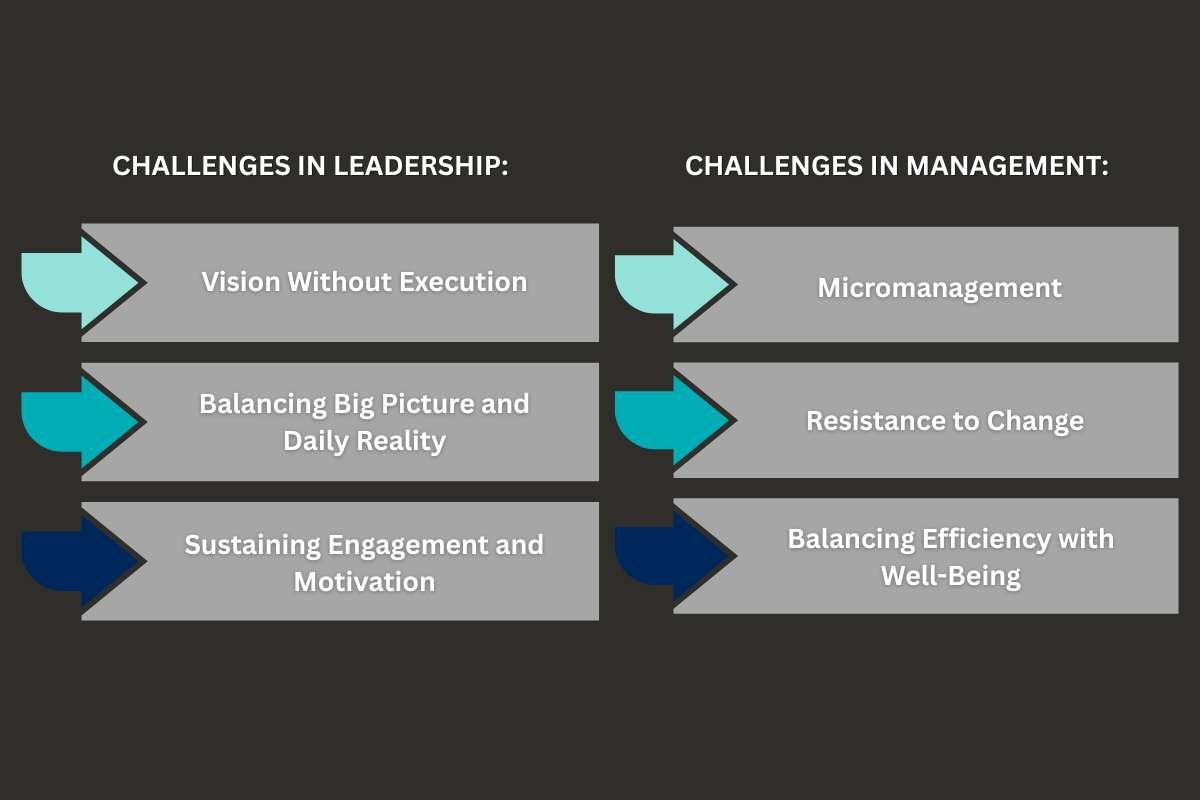Are great leaders born to inspire, while managers are wired to organise, or can one person truly wear both crowns? It’s a question that has challenged boardrooms, startups, and business schools for decades. The truth is, leadership and management aren’t rivals; they’re two sides of the same coin, and the best organisations know how to balance both.
A recent Gallup study reveals that companies combining strong leadership vision with effective management execution see 21% higher profitability and 17% greater employee engagement. Yet, many professionals still blur the line between inspiring a team and directing one. Leadership is about shaping the future; management is about making sure the present runs smoothly. When one falters, innovation or stability often suffers.
In this blog, we’ll dive deep into the leadership vs. management debate, unpacking what truly separates the two, where they overlap, and why mastering both could be your biggest career advantage. Expect actionable insights, real-world business examples, and a clear roadmap to help you lead with vision and manage with precision.
What is Leadership?
Leadership isn’t about holding a title; it’s about inspiring and guiding others toward a shared vision. As John C. Maxwell, a renowned leadership expert, famously said: “A leader knows the way, goes the way, and shows the way.” Leadership is less about authority and more about influence, motivation, and impact.
Research backs this, a Harvard Business Review study found organisations led by highly engaged and visionary leaders are 13 times more likely to outperform competitors. Leadership helps people understand why their work matters. This is where leadership vs. management starts to show its importance.
Modern leadership emphasises empathy, emotional intelligence, and collaboration. For example, Satya Nadella, CEO of Microsoft, transformed the company’s culture by promoting a “learn-it-all” mindset instead of a “know-it-all” one. His leadership didn’t just drive profits; it reshaped mindsets, encouraged innovation, and built trust, contributing to Microsoft’s market value tripling since 2014.
Key traits of effective leaders include:
| Vision | Seeing opportunities others might miss and communicating them clearly. |
| Empathy | Understanding and connecting with team members. |
| Integrity | Leading by example to build trust. |
| Decisiveness | Making confident decisions, even in uncertainty. |
| Adaptability | Adjusting strategies without losing focus on goals. |
In short, leadership is about painting a future others can believe in and guiding them to achieve it. Next, we’ll explore management, the complementary skill that ensures that vision is executed efficiently and effectively.
What is Management?

While leadership is about vision, management is about execution. Peter Drucker, the “father of modern management,” once said: “Management is doing things right; leadership is doing the right things.” In essence, management ensures that goals are met efficiently, resources are optimised, and day-to-day operations run smoothly.
Management involves planning, organising, coordinating, and monitoring tasks. A manager creates structure, assigns responsibilities, and keeps the team on track. Without effective management, even visionary leaders can struggle to convert ideas into results, a core concept in leadership vs. management.
Consider Indra Nooyi, former CEO of PepsiCo. Her management skills complemented her leadership vision: while she inspired innovation and a long-term strategic vision, she also implemented efficient processes, operational controls, and performance metrics that ensured her strategies were executed successfully. This balance helped PepsiCo maintain steady growth while innovating new products globally.
Key traits of effective managers include:
| Organization | Keeping tasks, teams, and processes structured and streamlined. |
| Problem-solving | Quickly addressing challenges that could slow down progress. |
| Decision-making | Making practical, data-driven choices to keep projects on course. |
| Delegation | Assigning tasks to the right people to maximise efficiency. |
| Monitoring & Control | Tracking progress, evaluating results, and implementing improvements. |
In short, management translates vision into reality, making sure that teams and resources operate effectively. Next, we’ll dive into the leadership vs. management, highlighting why understanding both is critical for personal growth and business success.
Key Differences: Leadership Vs. Management
Leadership and management are often used interchangeably, but they serve distinct purposes in any organisation. While leadership focuses on vision and influence, management emphasises structure and execution. Understanding these differences is crucial for maximising both personal growth and business performance.
Leadership Vs. Management: Here’s a side-by-side comparison
| Aspect | Leadership | Management |
| Focus | Inspiring and guiding people toward a vision | Planning, organising, and controlling resources to achieve goals |
| Approach | Motivates and influences | Directs and supervises |
| Decision-making | Often innovative, risk-taking | Structured, data-driven, risk-averse |
| Relationship with Team | Builds trust and influence | Maintains authority and accountability |
| Time Orientation | Long-term vision | Short-term goals and efficiency |
| Key Question Answered | “Are we doing the right things?” | “Are we doing things right?” |
| Example | Satya Nadella is transforming Microsoft’s culture and vision | Indra Nooyi is implementing operational controls and strategies at PepsiCo |
Both roles are complementary. A visionary leader without strong management may struggle to execute ideas, while an excellent manager without leadership may fail to inspire innovation or team commitment. The real magic happens when both leadership and management skills are combined, creating a high-performing, motivated, and efficient team.
Next, we’ll explore the similarities between leadership and management, showing where the two intersect and reinforce each other.
Similarities Between Leadership and Management

Although leadership and management are different in focus and approach, they share several critical similarities that make both essential for organisational success. Understanding these overlaps helps professionals leverage their skills effectively, blending inspiration with execution.
1. Goal Orientation
Both leaders and managers aim to achieve specific outcomes. While a leader focuses on the big picture and vision, and a manager focuses on processes and efficiency, both work toward the same organisational objectives.
2. Decision-Making
Decision-making is central to both roles. Leaders make strategic, long-term decisions to drive vision, while managers make tactical, day-to-day decisions to maintain operational efficiency. Both require judgment, analysis, and responsibility.
3. Communication Skills
Clear and effective communication is critical in both leadership and management. Leaders communicate vision and inspire teams, while managers ensure instructions, expectations, and feedback are clearly understood.
4. Problem-Solving
Both roles involve identifying challenges and finding solutions. Leaders tackle obstacles that affect strategic goals, whereas managers handle operational or logistical issues.
5. Influence on Team Performance
Whether through inspiration or supervision, both leaders and managers directly impact team motivation, engagement, and productivity. Successful organisations often have individuals who can fluidly move between these roles depending on the situation.
Example:
Consider Sheryl Sandberg, former COO of Meta. She demonstrated leadership by driving the company’s vision for global connectivity and management by establishing structured teams and scalable processes. Her dual approach ensured Meta’s projects were both innovative and efficiently executed.
While leadership and management differ in style and focus, their common goal is organisational success. Mastering the overlapping skills of communication, problem-solving, and team influence enhances both personal effectiveness and business outcomes.
Next, we’ll explore how leadership and management together drive business success, showing why organisations need both in harmony.
Leadership vs. Management in Business Success
Leadership and management play distinct but interconnected roles in driving business success. While leaders focus on vision, innovation, and motivating teams, managers ensure that processes, resources, and operations are efficiently executed. Organisations that balance both tend to outperform those that emphasise only one.
Impact on Organizational Performance:
Leadership fuels innovation and long-term growth, while management maintains operational stability and consistency. Without either, businesses risk stagnation or chaos.
Real-World Examples:

- Apple Inc.: Steve Jobs exemplified visionary leadership, inspiring teams to create groundbreaking products. Meanwhile, Tim Cook, with his management expertise, optimised Apple’s supply chain and operational efficiency. Together, leadership and management fueled Apple’s continued market dominance.
- Amazon: Jeff Bezos provided the long-term vision of customer obsession and innovation, while operational leaders implemented management systems to ensure efficiency in logistics and technology operations.
Key Takeaways:
- Businesses need both visionary leadership and competent management to scale successfully.
- Leadership encourages employees to think creatively and embrace change, while management ensures that these ideas are executed effectively.
- Professionals who develop both skill sets are more likely to drive innovation, optimise performance, and advance their careers.
In short, leadership sets the direction, while management keeps the ship running smoothly. Organisations that excel in both areas consistently outperform competitors, innovate faster, and maintain higher employee satisfaction. Next, we’ll explore Leadership Styles vs. Management Styles, helping you understand how different approaches impact teams and business outcomes.
Leadership Styles vs. Management Styles
Understanding the different styles of leadership and management can help you adapt your approach depending on your team, goals, and situation. While leadership focuses on inspiring people, management focuses on organising and controlling processes, and each has multiple styles suited to different contexts.
Common Leadership Styles:
| Leadership Styles | What is it? | Examples |
| Transformational Leadership | Inspires innovation and motivates teams to go beyond expectations. | Elon Musk encourages ambitious thinking at SpaceX and Tesla, pushing teams to tackle seemingly impossible challenges. |
| Servant Leadership | Focuses on serving the team, prioritising employee growth and well-being. | Satya Nadella at Microsoft emphasises empathy and learning, fostering a supportive culture. |
| Transactional Leadership | Uses rewards and consequences to drive performance. | Example: Sales managers often use performance-based incentives to achieve targets. |
| Situational Leadership: | Adapts style depending on the team and situation. | Example: A project leader shifts between hands-on guidance for new employees and delegating tasks to experienced ones. |
Common Management Styles:
| Management Styles | What is it? | Examples |
| Autocratic Management | Makes decisions independently and expects compliance. | In high-pressure industries like manufacturing, quick, centralised decisions ensure efficiency. |
| Democratic Management | Encourages team input in decision-making. | Product managers at tech startups involve engineers and designers in planning new features. |
| Laissez-Faire Management | Gives teams freedom to make decisions and solve problems independently. | Research teams in innovation labs thrive under minimal supervision. |
| Bureaucratic Management | Follows strict rules, procedures, and hierarchies. | Banks and regulatory organisations use structured protocols to minimise errors. |
Key Insight:
- Leadership and management styles are not one-size-fits-all. The best leaders and managers adapt their approach to the team, project, and organisational culture.
- Combining a visionary leadership style with an efficient management style can motivate teams while ensuring that goals are achieved on time and within resources.
Next, we’ll look at the common challenges in leadership and management, highlighting pitfalls to avoid and strategies for overcoming them.
Leadership Vs. Management: Challenges

Even the most skilled leaders and managers face obstacles and often, the very qualities that make them effective can also create hidden pitfalls. Understanding these challenges is essential for professionals aiming to grow personally, inspire their teams, and drive business success.
Challenges in Leadership:
1. Vision Without Execution:
Leaders often excel at painting a compelling picture of the future, but without actionable steps, these visions remain dreams. Teams may feel inspired initially but frustrated over time if strategies aren’t grounded in reality.
Example: A startup founder might excite employees with a revolutionary product idea but neglect detailed planning, resource allocation, or timelines, causing projects to stall.
2. Balancing Big Picture and Daily Reality:
Leaders naturally focus on long-term goals, yet ignoring operational realities can derail progress. It’s a constant tightrope walk: innovating for the future while ensuring the present is stable.
Example: A company rolling out an ambitious new technology may struggle if manufacturing capacity, budget, or logistics aren’t carefully managed alongside the visionary plan.
3. Sustaining Engagement and Motivation:
Inspiring employees consistently is a formidable challenge, especially when facing setbacks, organisational changes, or market pressures. Leaders must continuously connect their vision to tangible, motivating outcomes.
Challenges in Management:
1. Micromanagement:
Over-controlling tasks can suffocate creativity and reduce team morale. Even capable employees may feel stifled when their autonomy is restricted.
Example: A manager who insists on approving every minor decision in a design team may slow innovation and frustrate talented creatives.
2. Resistance to Change:
Managers who cling to existing processes may struggle in fast-paced industries. Adaptability is key; rigid structures can become bottlenecks.
Example: A manager insisting on outdated reporting methods can slow digital transformation, making the organisation less competitive.
3. Balancing Efficiency with Well-Being:
Meeting deadlines and achieving operational targets is important, but overemphasising efficiency can lead to burnout and disengagement. Maintaining team morale alongside performance metrics is a delicate balance.
Example: Tight project timelines without flexibility may achieve short-term success but increase turnover and reduce long-term productivity.
Strategies to Overcome These Challenges:
- Blend Leadership and Management Skills: Inspire teams with vision while providing structured processes and clear accountability.
- Foster Open Communication: Create channels for feedback, ensuring challenges are addressed before they escalate.
- Stay Flexible and Adaptable: Adjust your approach based on evolving team needs, project demands, and market conditions.
- Invest in Continuous Learning: Regularly enhance emotional intelligence, problem-solving abilities, and operational expertise.
Challenges are growth opportunities when approached with the right leadership vs. management mindset. Leaders and managers who balance vision with execution, inspiration with structure, and motivation with accountability cultivate resilient teams that thrive under pressure and deliver exceptional results.
Next, we’ll conclude with a powerful summary, tying together the lessons of leadership and management to help you apply them effectively in your career or organisation.
Conclusion
Leadership vs. Management is a synergy. Leadership is about inspiring people and setting a vision, while management is about organising work and making sure goals are met.
The best results happen when you combine both. Leaders like Satya Nadella and Indra Nooyi show that inspiring a team while keeping operations on track creates success, growth, and motivated employees.
Leadership gives direction, and management keeps things on track. Using both together improves team performance and business results. Being flexible, communicating clearly, and continuously learning help overcome challenges.
In short, mastering leadership vs. management equips you to turn ideas into results, build high-performing teams, and achieve lasting success.
FAQs: Leadership vs. Management
1. What is the main difference between leadership and management?
Leadership focuses on inspiring people and setting a vision, while management focuses on organising work and making sure goals are achieved efficiently.
2. Can someone be a great leader but a poor manager?
Yes. A person may inspire and motivate a team but struggle with planning, organisation, or follow-through, which can affect results.
3. How can I improve both my leadership and management skills?
Practice clear communication, set goals, delegate tasks, inspire your team, stay adaptable, and continuously learn from experience and feedback.
4. Which is more important for career growth: leadership or management?
Both are important. Leadership helps you inspire and guide others, while management ensures results. Combining both skills makes you more effective and valuable.
5. How do leadership and management styles affect team performance?
Leadership styles influence motivation, innovation, and culture, while management styles affect efficiency, structure, and accountability. Using the right mix improves overall team performance.













